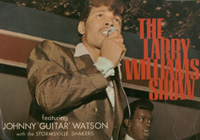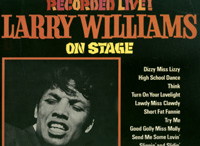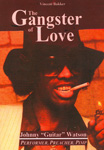WITH LARRY WILLIAMS IN 1965
Larry had asked me to send him any reviews I might see for the two albums we’d recorded with him on the 5th and 6th of April. The reviews were mixed, particularly critical of the Decca studio L.P. but I sent them anyway, along with a plea for him to look out for American songs we might record. The Stormsville Shakers and I felt strongly that if we could find a hit song, then we could clinch a recording contract. We hadn’t had much luck getting “discovered” despite turning pro and practising at the Ricky-Tick club, Windsor every day that we didn’t have a gig.
Larry replied June 9th. His typewritten letter was addressed to the Stormsville Shakers - Dave Sherrington & Tony Hurley on saxes, Ivor Shackleton guitar, Kirk Riddle bass and Dick “Fancy” Forcey our drummer and me. He began in typical up-beat fashion, the way he spoke with us on tour. He liked to affect an English upper-class accent especially when calling out to “Doctor Johnny “guitar” Watson”. He thought it was funny and it did crease us but only because his accent was so bad:
“Hi, fellows,
I received your letter today, very happy to hear from you. But I’m sorry to hear that you are having troubles with recording. Thanks for sending me the clippings on the LPs. They really got things messed up. I read that part about Johnny ‘Guitar’ Watson’s Stormsville Shakers. Not only that, I think they are wrong about the Sue LP. I like it too. But the Decca LP is the best. I don’t care what they say. And the kids aren’t crazy, all they have to do is hear them both and I bet the Decca LP turns out to be the best.
But you know what it really is? The Sue LP was live. That helps. And it contains all of my biggest hits whereas the Decca LP is something new that they never heard before. People accept you for one thing and it’s hard to get them to change. I knew this when I cut the Decca LP. But that’s just what I want. The Decca LP is the first time I’ve had to show them another side of myself.”
This was certainly true enough. We loved his rock ‘n’ roll songs but by 1965, original rock ‘n’ roll was unfashionable. Nevertheless Larry attracted a loyal following and working with him and Johnny “guitar” Watson had been a gas. Like many visiting Americans, due to Musicians Union reciprocal agreements in the UK and USA at the time, he was forced to work with any pick-up, British band, his UK agent or promoter provided. There was never any rehearsal time but in the Stormsville’s case, that didn’t matter. We were fans and knew his records well. Also, as we were to discover, Larry loved r ‘n’ b, James Brown & Bobby “Blue” Bland, songs that suited our two-tenor sax line-up.
It was normal practice for an Agent to book a visiting artist from the U.S. for a fixed fee for a few weeks and sub-let as many dates as possible to other promoters to make a profit. The more gigs, the more profit and so two shows-a-night was not unusual, sometimes three.
Bill Millar (in Now Dig This magazine issue 312, March 2009) says Larry was disappointing at Leyton Baths on the 26th March. I recall that venue having acoustics that echoed unmercifully, although the Stormsville’s didn’t back him on that particular night. We were playing the Corporation Hotel, Derby. However, after midnight, we returned to London for an All-Nighter at the Flamingo club, so technically it was the 27th. And although I have no recall of working the Flamingo with Larry Williams, it is probable we met up there in the wee wee hours. For one thing, I had an electric piano (a Hohner Cymbalet model) and terrible amplification! Larry was fascinated by it and even recorded an instrumental “Stormsville Groove” on his Decca album using it. The case for the Shakers not actually backing Larry & Johnny on that night may be evidenced by Dave Hastings’ photos in the magazine, one of which shows a tenor-player unknown to me, in the background.
The Plaza Ballroom, Guildford was one of my favourite venues in my home town. It was used as a Ricky-Tick club venue and promoters Philip Hayward & John Mansfield arranged for the Stormsville Shakers to back Larry Williams there. The photo on the cover of Larry’s Decca LP was taken there April 2nd. Unsurprisingly, the gig was a big success and the following night we were booked together again at the Twisted Wheel Club, Manchester. We met there early with our American friends, intending to rehearse but instead, we frittered away the hours in a nearby coffee bar. Larry signed my 45 rpm copy of “She said yeah” and Johnny Watson cracked us up complaining that English coffee was served in such small cups. He addressed the waiter with mock despair “What do ya call this, eye wash?”
Johnny was the craziest band leader. Larry would normally begin a song with piano and then Johnny would lead us into it at break-neck speed. It was like clinging on to a fairground ride. He’d alternate solos with Larry’s piano and occasionally turn to David or Tony for an impromptu sax solo. Johnny’s guitar solos were dynamite. He was Chuck Berry and Jimi Hendrix rolled into one. The faster the ride, the more exciting it seemed. Midnight in Manchester and the promoter wanted more.
A debate began about money. I believe Larry, who had not been booked to play an after-midnight show, saw the opportunity to earn. My own problem was that the Stormsville Shakers were due to gig at the Witch Doctor Club in Hastings the next night. Remember, without a motorway network, that journey involved a slow crawl through the night. Larry wasn’t going to pass up extra reward and we parted, leaving him to work with a local band, while we drove south through the night. We agreed to meet again at Decca recording studios on the Embankment, London the following day, 5th April.
“So don’t lose heart about the recording hassle.” Larry wrote. “We all have problems with that end of the thing.”
In retrospect I wonder if being on the Specialty label alongside Little Richard wasn’t later like me being on DJM Records in the ‘70s with Elton John.
“Then too, you guys are something like me because you are trying to record with horns, about the same type of thing I’m doing.”
Larry liked our repertoire and that was what made it easy for us to work together. He was also tremendously encouraging. He told me my voice reminded him of Chris Kenner.
“You like Bobby “Blue” Bland and James Brown, Otis Redding, the SOUL type of thing. And England just ain’t ready for this yet. True some like it, but most don’t. Like you said in your letter, groups record mostly with guitars and have another kind of SOUL. It may take a while but you’ll make it. Take the Righteous Brothers, it took all this time for them to make it. They’ve been here in Los Angeles for six years doing the same thing. But if you got SOUL it’ll come to the front in the long run.”
We worked all day on the 5th making an album. I played a little electric piano but otherwise I was superfluous. I listened while Larry and Johnny discussed writer/publishing credits and as night time came around and we took a break, I asked again if they knew a “hit” song my band could perform. Larry spoke with Johnny and asked for the tape machine to roll. Dick “Fancy” Forcey played drums on two songs he’d never heard before and Larry presented me with an acetate of “How many times”, a song he said he’d just written. It sounded just like one of those New Orleans songs that might have been on the London label’s classic album “We sing the blues”. Unfortunately I didn’t have the skills of Allen Toussaint to make the most of it!
Larry was a generous guy. And he was free with honest advice. He wrote “As you asked in your letter, I’ll be happy to send you some tunes. Just promise me one thing, you’ll keep on trying to make it. I’m betting on you. Do you remember what I told you the first night I met you? If you gonna be BIG, you must have a record. So concentrate on that. I’ll help you all I can. I’ll be sending you some tunes in about a week or so.”
The most shocking part of the Decca recording was Larry’s insistence that he wanted to record the Yardbird’s “For your love”. It was sacrilege for me and the Stormsvilles. Here we were working with one of the pioneers of rock ‘n’ roll and he wanted to be a mop top! But like he said in his letter later, “It’s the first time I’ve had to show them another side of myself.” We did record a reasonable version of “Slow down” though, which Decca released as a single but in all honesty, I prefer the Specialty original.
I think Johnny “guitar” Watson had to return to the States. I recall they had hushed words in the Embankment studios about another recording, for Sue Records, and Johnny couldn’t be there. I also suspect that Decca were relying on some exclusivity for its recording but that’s just a guess. Whatever, as the evening of the 5th wore on, an offer was put to me for the Stormsville Shakers. We were to turn up at the Marquee studios (not the club) the next day.
The “live” album for Sue was really a recorded album done before a live audience. Screamin’ Lord Sutch, who we were friendly with from numerous encounters “on the road” was cheerleader (with football rattle) for a small invited audience, (including Screamin’ Jay Hawkins who the Stormsvilles had supported earlier at a Ricky-Tick club). They were mostly inebriated and were crowded in the corner of the studio. In answer to Mike Pemberton’s letter (NDG 309) there could be more recorded material but…it was not a continuous recorded show. Although we didn’t perform “She said yeah” with Larry, it was one of our favourite songs of his, maybe because of the sax riff. So we agreed to introduce each set of three “live” songs with the “She said yeah” sax riff, then take a break. Larry would then go into the studio control room and make sure he was happy with the previous ‘take’ of three songs. If so, we’d begin another three, starting with the “She said yeah” intro. If not, we could drop or re-record a duff song in the next trio. The result was a musical device that allowed the engineer to connect all the recordings together as if it had been a continuous performance interspersed with Larry’s “She said yeah” theme! The result was, to my ears, a fabulously exciting record and whatever Larry’s hopes for his Decca L.P., it remains exciting listening today and, incidentally, proof that the Stormsville Shakers were “ s**t hot” in 1965.
I heard no more from Larry after June 1965. His letter had ended with some words for our drummer who had a style modelled on Phil Seaman and his protégé, Ginger Baker. Larry wrote like he spoke:
“Dick, you know something? I used to have a drummer named Dick. He was with me for four years. You play like him. And last but not least, you both are left- handed.” I never knew who the American left-handed drummer was, that Larry referred to. I’d like to know?
I enjoyed my time with Larry Williams, brief as it was. Johnny “guitar” Watson found fame in the seventies as a Shaft-style “super-spade” but I reckon I saw a better musician in 1965. One month after Larry left England, the Stormsville Shakers met Chris Andrews and I finally learned to write songs myself.
Larry closed his letter to me urging us to “Keep on “PUSHIN’”.
Kindest personal regards,
Larry Williams
3311 W. 63 St.
Los Angeles, Calif.”
He was found dead at his Hollywood home in January 1980, a bullet through his head. Though judged to be suicide, many believe he was murdered in a drug-related crime. Looking back on our time in the sixties, certainly Larry was a ladies man (well he did write songs about boney Maronie, Miss Lizzie, Short Fat Fannie and others) and he carried with him a reputation for pimping. In 15 years following his leaving Blighty a lot could have changed but in my time with him, I never saw him take, nor did he offer, me or my band drugs. Finally, based on our brief relationship, I don’t believe Larry Williams committed suicide. But I sometimes look at Venus William’s widow’s peak and wonder if the tennis ace is distantly related to Larry? If I were a sports journalist, it would be my first question!
PHILLIP GOODHAND-TAIT
©2009 Phillip Goodhand-Tait.
Now Dig This is published monthly.
Mail order price 1 copy direct £4 UK, £4;25 Europe or £5:20 Rest of the World.
Credit Card Hotline:0191 263 6767
COMING SOON!
2. PG-T quotes including the famous 'eyewash' anecdote in Vincent Bakker's new book on JOHNNY 'guitar' WATSON - 'The Gangster of Love'. ISBN 978-1442141476 |
|

 Who
was Larry Williams?
Who
was Larry Williams?
